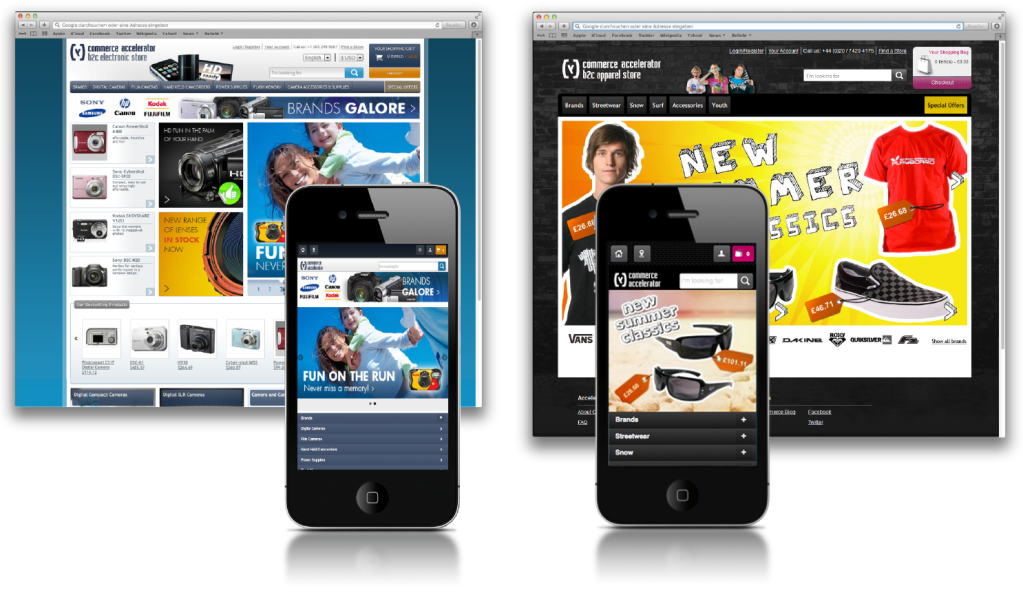15% per year is a forecast increase in e-retail in Poland in 2014 according to the consulting company PMR. The facts are unquestionable. Almost every company that wants to continue to grow or maintain its market share must build its Internet presence. In 2013, Hybris Commerce Suite joined the group of SAP products, replacing Web Channel Experience Management. Since then, SAP has been providing solutions for each distribution and communication channel which is currently used, as well as the possibility of their integrated management. This makes it a pioneer and the only large player in the world with such a broad offering.
eCommerce yesterday…
The first steps for companies which wanted to build their presence in the Internet, were the attempts to launch informational Web sites and online B2B and B2C stores. At present, we are experiencing an era of mCommerce euphoria, i.e. allowing the customer to access online stores and other services via mobile devices such as smartphones and tablets. At the same time, online stores are developed, companies interact with potential customers using Facebook, Twitter and other social media sites. Additionally, call centers are launched, advertisements in the press, radio and television are published, flyers with a current offering are issued. Companies are trying to control the relationships with customers using Customer Relationship Management systems…
There are plenty of great solutions that are suitable for individual channels of communication and distribution. The challenge that comes up nowadays is no longer the company’s presence in the individual channels, such as eCommerce and Social Media.
…Omnichannel tomorrow
According to the research made by the CFI Group for eBay, 95% of customers “often or sometimes do their shopping both in physical and online stores of a given brand." In fact, hardly anyone does shopping using only one channel, closely following a defined shopping path. A typical person encouraged by a TV commercial is looking for information on an FB profile and buys a product through a B2C store. Another potential customer finds out about an offering when reading comments on a product on Twitter, checks the price using a price comparison website, goes to an online store, and then makes a purchase at POS. Each customer follows his/her own purchasing process.
The OmniChannel Order Management function in Hybris supports the sales through multiple channels, bringing the potential customer’s shopping process closer to his/her individual habits rather than to the processes rigidly defined by the system developers.
The challenge is the unification of the image of an offering in the customer’s eyes – making it coherent in various channels. Currently, it is unacceptable to make the customer who came to POS to buy the selected product order it through an online store since a shop assistant cannot sell the goods due to the limitations of their sales process. The Hybris solution enables the customer to make the purchase in as many ways as he/she comes up with:
- online ordering and shipment,
- online ordering and pickup at POS,
- ordering and pickup at POS,
- ordering at POS and later shipment (e.g. if the product is not currently available in the store).
In addition, it is possible to easily manage multiple product catalogs in such a way that the customer does not have to wonder whether the product which he saw in the newspaper advertisement is the same one that is viewed by him in the online store or POS. The high importance of the above is shown by the already quoted CFI Group research: “75% of customers who asked questions about the offering in a different sales channel were provided by the store personnel with incorrect information frequently or occasionally".
Hybris stores information about each product at a single place (the PCM module), and a store administrator decides which information is to be visible, e.g. in a product catalog printed for a trade fair, and which one in the B2B Web store. It saves the time spent on preparing an offering and at the same time ensures that the desired characteristics of the product will be highlighted in the selected catalogs.
From the perspective of the company it is very important to identify an Internet user browsing the product data sheet on his/her smartphone, a guest of a physical store viewing selected merchandise, as well as a person contacting the call center as the same person. It a false assumption that each of the above interactions has different participants and from beginning to end runs according to the business processes established by the creators of a given channel.
An advanced personalization feature can be helpful here. Based on the information from the customer’s profile and the session profile, such as the customer’s FB profile, his/her comments, a product browsing history, searches and many other, it enables the customization of the content viewed by a potential customer. An example can be a list of products recommended for a specific individual and a promotion generated specially for this person.
Evolution of distribution channels
eCommerce
Most of the companies’ strategies related to eCommerce are based on the implementation of an e-shop. This is the only similarity. The key thing seems to be the optimization of the purchasing process through its maximum simplification – to allow the customer to achieve the set goal in a simple way – gathering the information about the product, facilitating the decision-making and hassle-free purchasing.
In the case of a B2C store it could be the introduction of a purchase option without the need to create an account in the store. Eight out of ten largest B2C stores in the US offer shopping as a guest. Another idea is to allow the customer to pick up the ordered goods in a selected POS. According to the research by Hybris, ca. 60% of orders are fulfilled in this way. All of these options are supported in the Hybris Commerce Suite standard.
Also in the B2B shop, there are many ways to optimize sales. An example can be the preparation of a special catalog with products marked in the customer’s standard in order to facilitate identification for a regular customer whose volumes of purchases in our store is large. It is very easy to create sophisticated product catalogs in the PCM Hybris module (e.g. by dragging and dropping the products to a catalog). The next step can be the personalized pricing for a selected customer, with taking into account, for example, the discounts predetermined in a framework agreement. The incorporation of Hybris tools into the family of SAP solutions enables the use of the Pricing feature in SAP. There are two approaches to be selected:
- Pricing in Hybris – asynchronous,
- Pricing in SAP – synchronous (for B2B only).
Both types of stores: B2B and B2C include a valuable function of easy adaptation of individual store web pages (e.g. a product data sheet, a home page, search results) using the WYSIWYG (What You See Is What You Get) editor. In addition to the use of the WYSIWYG editor, the WCMS module in Hybris enables also e.g. the definition of individual slides in a slider on the store home page with a few clicks of the mouse. The same effort is required to edit a menu or add a banner. As a result, some modifications of the store can be performed by a person without any technical competencies.
mCommerce
In the middle of 2014, almost 50 percent of surveyed representatives of the Polish e-stores said that they intended to implement mobile solutions in the following six months (research by mGenerator.pl). It is no longer sufficient to enable customers to view a product catalog or to create an order on mobile devices by simplifying the store and cutting out scripts that do not run on some smartphones. A potential customer using the mCommerce platform navigates through an e-store in a different way than using a computer. He also requires a simplified look and feel, clear fonts and a sensible layout of all elements to ensure that the presented content is legible.
For example, a customer stuck in a traffic jam would like to quickly order a gift for his wife, and then pick it up at the nearest shop. He won’t need much information on a product data sheet to make a purchase (all additional data can be found by clicking the “More Information" button). All that interests him is a short description, price and information where he can pick up the gift. Often, such purchases are made in different environments and in different situations, which requires specific adaptation of this type of platform to circumstances in which the customer is at a specific time.
The Hybris platform enables the individual adjustment of each web page to a mobile store (e.g. a product data sheet, search results, a home page). What’s more, developers are provided with programming environments (Hybris Mobile APP SDK) for iOS and Android. A potential customer can install himself a mobile application on his phone and in this way make the ordering process in the store run easier and faster.

Examples of online stores and their mobile versions – customized using the Hybris platform
Printouts
In some industries, the majority of marketing activities are carried out with the use of printed brochures, product catalogs for fair trades or advertising flyers. In this case, the problem is to maintain the consistency of information about an offering with the current product base. Several separated departments (e.g. from the online store and advertising flyer) are forced to make the same descriptions of the same product, losing time and risking that their description – published in several places – will be inconsistent.
The Hybris module dedicated for printing allows you to reuse the same product description and save time in this way. In addition, it is possible to integrate it with Adobe InDesign, which is used by most external agencies to create this type of publication.
POS
The consistent implementation of the omnichannel strategy means also providing a customer visiting a point of sale with reliable and consistent information on the product offering which he/she could read earlier in the e-shop or see in the printed brochure. The support of QR codes and NFC tags will facilitate access to our services for a potential customer. All of these features are provided by the dedicated Hybris InStore module.
Use every sales channel
According to Marketing Sherpa, 80% of people making purchase decisions found their suppliers themselves. The conclusion is that we should focus on informing a potential customer about our offering in the best possible way (a catalog of products in the PCM Hybris module is helpful here) and facilitate access to such information (layout optimization in the WCMS module and access via mobile devices, the printing module and POS support).
You can launch the Hybris platform out-of-the-box and then customize the store based on the preconfigurable version. This allows you to skip the design phase, to launch the store faster and, as a result, to lower TCO.
Hybris is a global market leader in eCommerce solutions. When implementing the omnichannel strategy, it pays to use the best tools available.


